The History of the Trakehner Horse
Trakehnen
The Trakehner horse is the oldest warmblood breed in the world, with a history spanning amost 300 years to the foundation of the main stud Trakehnen in 1732. The official name, "The East Prussian Warmblood Horse of Trakehner Origin" hints to the roots of this magnificent breed: the region of East Prussia once belonging to Germany, but lost during World War II to Russia. The origin of the breed is a small horse - bred locally in East Prussia - known as the "Schwaike". The Schwaike was known for its versatility and endurance. When this breed was crossed with imported English thoroughbred and Arabian stallions, the resulting horse was named after the main stud it came from: Trakehnen. The original purpose of the Trakehner was for use as calvary mount.
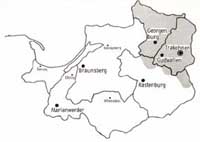 In the early 18th century, King Friedrich Wilhelm I realized that a new type of cavalry mount was needed as war tactics had changed and demanded a faster, lighter horse that also posessed power and endurance. In 1732, he moved the best of his cavalry horses to the new royal stud farm Trakehnen and began to systematically breed a horse that would meet many criteria. The new cavalry mounts had to be attractive enough to be a representative horse for his officers, but additionally had to be tough enough to survive harsh situations and come out sound. Through his efforts, the Trakehner breed evolved. In the early 18th century, King Friedrich Wilhelm I realized that a new type of cavalry mount was needed as war tactics had changed and demanded a faster, lighter horse that also posessed power and endurance. In 1732, he moved the best of his cavalry horses to the new royal stud farm Trakehnen and began to systematically breed a horse that would meet many criteria. The new cavalry mounts had to be attractive enough to be a representative horse for his officers, but additionally had to be tough enough to survive harsh situations and come out sound. Through his efforts, the Trakehner breed evolved.
At the same time, East Prussian farmers were breeding the same base of horses, but for the daily work in the fields. Soil in East Prussia was always heavy and deep, and from today's point of view it might seem strange that noble Trakehner horses were pulling ploughs through thick mud, but from the standpoint of breed selection, it is a major reason the Trakehner soon had the reputation of a hard-working animal with little need for maintenance.
The castle at Trakehnen, home of the stud manager |
|
Trakehner brood mares working in the field
|
|
Trakehner herd returning home
|
|
|
East Prussia therefore had two separate, but equally outstanding sources for riding horses. The military and civilian herds were mixed often, further consolidating the best possible traits. The main stud Trakehnen was a huge compound, a city of its own, covering some 15.000 acres. Apart from the main complex, sixteen "Vorwerke" (more distant barns) were home to the famous mare herds. The Trakehner horse was bred depending on its color; which may sound strange but made perfect sense once one takes into consideration that the differently colored herds also showed certain traits that were useful for the population. The black herd at Gurdzen for example consisted of mares that had the most substance and were very strong and outstanding "workers". Famous stallions like Ararad and Jagdheld were crossed with these mares, mainly to maintain a balance to the otherwise very refined Trakehners. Even today, these "heaviers" genes can come through in the descendants of this great herd.The chestnut mares were collected at Trakehnen itself. Descending from famous thoroughbreds like Thunderclap xx, the chestnut mares were elegant, sensitive and exhibited the greatest performance potential. One of the most successful dressage lines of all times in warmblood breeding, the Hanovarian A-line, founded by the Trakehner stallion Abglanz, originated from the chestnut herd. Bay and brown mares were collected at Kalpakin. They were known for outstanding temperament and again, excellent rideability. And at Bajorgallen, the "mixed herd" was stationed. Here mares of all colors including the gray horses were bred to many of the Arabian stallions. Foundation mares like Kassette and Donna came out of that exquisite group of horses and even today, 60 years after their time are the most prominent names in the history of Trakehner horses.
A chief sire at Trakehnen lived like a king. Each stallion had a huge paddock that was fenced by trees and bushes. The stall was a stone house, open to one side, built like a round pen with a luxury roof and beautiful steel ornaments. Each stallion was assigned a private groom, always older and proven men that had spent their lives at Trakehnen and had that special "6th horse sense" built in.It must have been a special view each morning when the men opened the giant barn doors at Trakehnen and waves of gleaming horses made their way along the paths to the pastures. There were no fences at Trakehnen, the horses were guarded by a man on a horse, watching over "his" friends every day. Weanlings were kept in large herds and had all the freedom a young horse could dream of. At three years old colts were started under saddle and thoroughly tested to determine their future: cavalry, riding horse or future sire for Trakehnen and the East Prussian local studs. Obviously with so many high quality horses, only the very best were chosen as potential future sires. These - the cream of the crop - next underwent the stallion performance test. Performance testing lasted a full year and was held at Zwion, the state's stallion test station and the first of its kind in the world. The colts were driven, raced, used for hard fox hunting and eventing, trained in dressage and tested over jumps. All colts were evaluated thoroughly on character, rideability and temperament. Only the very best of these magnificent animals were chosen to contribute to the prestigious gene pool at Trakehnen. |
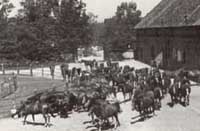 By far more mares were distributed among the smaller breeding farms of the East Prussian farmers than at Trakehnen. This resulted in an indigenous breed, which was the great advantage of the East Prussian as opposed to other breeds, since it made for a great consistency. Their quality improved as Trakehnen and the bigger private studs raised a large number of their foals. The state stallion depots and the riding and driving clubs formed their backbone. At local and national shows, they competed with larger breeders. By far more mares were distributed among the smaller breeding farms of the East Prussian farmers than at Trakehnen. This resulted in an indigenous breed, which was the great advantage of the East Prussian as opposed to other breeds, since it made for a great consistency. Their quality improved as Trakehnen and the bigger private studs raised a large number of their foals. The state stallion depots and the riding and driving clubs formed their backbone. At local and national shows, they competed with larger breeders.
But Trakehnen was much more than horses and people, operating one of East Prussia's biggest agricultural farms with 900 cows, 600 sheep and other farm animals. At this agricultural farm, a stock of 500 Trakehner horses was only used for farm work.With the addition of English and Arabian thoroughbreds the Trakehner achieved the great beauty, legendary soundness as well as the wonderful floating way of going and great jumping abilities that makes the Trakehner horse world-famous. Today, quality Thoroughbred and Arabian horses are allowed into the otherwise closed studbook. This consistency of breeding helps maintain the "Trakehner look", "freshens" the bloodlines and adds great rideability and sensitivity.
The Trakehner horse was the most successful sport horse in the world between the two World Wars. Olympic gold in dressage went to Piccolomini in 1924, and the silver medal went to Sabel. In 1936, the dressage gold medal was won by the 7-year old Kronos, the gold medal in eventing was won by the Trakehner Nurmi and the winning German eventing team was made up of two Trakehners and one Thoroughbred. The East Prussian warmblood horse was exported not only to Europe but all over the world. In 1938 some 478.000 horses lived in East Prussia with 1.289 stallions covering 89.628 East Prussian mares. Trakehners were used for all purposes: hard-working farm horses in the fields, courageous and sound cavalry mounts, for fox hunting, driving and last but not least for horse racing. Between 1921 and 1936, the hardest steeplechase in the world, the Pardubice steeplechase, was won 9 times by East Prussian horses.

Dominant Influential Sire Lines
Over the years, such
careful breeding and selection of breeding stallions created some legendary sire lines. These Chief Sires had a dominant influence on East Prussian breeding, which is still felt today. We can only give a few examples here.
Perfectionist xx |
|
Tempelhüter |
|
|
Perfectionist xx:
foaled 1899 in Great Britain. Perfectionist xx was purchased in 1903 by Count Georg von Lehndorff and stood as chief stallion in Trakehnen for three seasons from 1904-1906. He was most influential through his sons Tempelhüter, Jagdheld, Irrlehrer, and his daughter, Posthalterin, dam of the foundation sire Parsival. He reproduced his own image - strong, with good, correct movements. His offspring all had a lot of jumping talent and were good fox hunters. Today, this line is represented by stallions like EH Friedensfürst, Graditz *E*, EH Charly Chaplin or EH Mackensen through Tempelhüter; EH Tenor, EH Itaxerxes, Suchard, Königsstein and Impuls through Jagdheld; Carino *E* through Irrlehrer; Heling and Asher through Parsival and finally Horalas, Biotop and Carajan through Posthalterin by Tempelhüter.
Tempelhüter, who was chief sire in Trakehnen 1916-1931 was considered as the perfect example of the Trakehner horse. As illustration of his unrivaled significance, a statue of this magnificent stallion was erected in front of the Castle at Trakehnen where it remained until being taken as war booty to Russia after World War II. It was placed in fron of the Russian Horse Museum in Moscow. An exact replica of it was made possible in the early 1970s by efforts from Hans-Joachim Köhler, and in a very special moment, was introduced to the public in front of the Horse Museum in Verden, Germany.
At that time, the last horse originally born at Trakehnen, the chestnut stallion Keith by Pythagoras out of Ketzerin by Ararad, born in Trakehnen in 1942, was present (well into his 30s), and more than a few eyes were wet that night! |

|
Damfpross:
Dampfross, who came from the private stud farm of Lauszus in Stepponaten, county Ragnit in East Prussia, was born in 1913 and was acquired by Trakehnen as a chief sire in 1923, where he remained active until 1933. He was by Dingo out of Laura by Passvan, who was a son of the legendary Flügel. Flügel is the one stallion that today, is thought to have stamped his type into the breed, something that is referred to as "Flügel-type" today. Dampfross was the prototype of the warmblood horse, well-tempered, with an impeccable mind, outstanding, powerful movement, excellent health and high general athleticism. Experts agree that even today, he would stand at the top of any warmblood breed. He proved to be a true stamping sire, and mostly came after his dam line. He sired 38 approved sons and no less than 35 of his daughter were recruited for the famous Trakehnen mare herds. His most influential son for the Trakehner breed was Pythagoras. In Hanover, it was Semper Idem who redefined the meaning of "athletic show jumper", even to this day: his descendant Stakkato stands at stud in Celle in 2006. Trakehner lines today include Ablganz (also important in Hanover!), Donauwind and Altan II.
Pythagoras:
Born in by Dampfroß out of Pechmarie by Tempelhüter. Chief sire 1933-1944, he was combining the blood of the two "Century Sires" Dampfross and Tempelhüter, Pythagoras was Trakehnen's leading sire prior to WWII. His son Totilas and daughter Tapete were instrumental in revitalizing the breed after the war. His influence even today is still strong through his sons Guido, Creon and Eifel. Guido leads to EH Marduc, EH Anduc, EH Hyllos and Solero TSF; Creon stands for Komet and thus Doruto (KWPN), Gunnar, Herzbube, EH Leonardo and EH Argument; and Eifel became a foundation stallion in Russia with stallions like Waitaki and Abrek. Pythagoras' daughters Hansastadt, Isola Madre and Alraune were of importance for establishing strong dam lines, and in addition to the above mentioned stallions, his sons Keith, Markwart, Sporn, Suomar and Pilgrim made sure the line stands on a strong foundation.
|

|
Cancara:
Cancara represented the idea of combining Arabian and English TB in an optimal manner. He was
Trakehnen's leading sport horse producer. Cancara was born in Trakehnen in 1917, sired by Master Magpie xx out of Cymbal by Nana Sahib x. He stood at Trakehnen from 1921 - 22 and again from 1932 on to the end. A remarkable horse, Cancara was an untiring performer under saddle, qualities which he transmitted very dominantly to his progeny. His daughters Donna and Kokette were two of the most outstanding broodmares in the history of West German Trakehner breeding. His daughter Pergamon produced two true "century" mares: Per Adresse, who is the foundation mare for the Peraea family (Pregel, Pret a Porter) and Pelargonie, foundation mare of the family of Peron TSF and EH Partout. Cancara's influence via sons did not survive WWII.
Fetysz ox:
Fetysz was foaled at the world-famous Janow Stud in Poland in 1927 and was acquired by Trakehnen in 1936 for the mixed herd. It was his son Famulus, who established the Trakehner breed's most valued dressage line. The line descends down to Flaneur and his son EH Arogno, as well as the Flaneur-daughter ES Maharani II, who is dam of the three dressage stallions Mahagoni, EH Mackensen and the lesser known Mahon. Fetysz ox was tragically shot by the invading Russian Army, but nevertheless left his legacy as even Olympic competitors today carry his valuable blood. Both above mentioned foundation mares Per Adresse and Perina were daughters of this legendary Arabian stallion.
|

War and Trek
During World War I, the population of the Trakehner horse was halved and it took great efforts of the breeders to bring the breed back to its former numbers and famous standard of quality. But in 1944, in the closing days of WWII, it seemed these heroic efforts would have been in vain.
In the harsh winter, as the Russian Army broke across the front lines and invaded East Prussia, people were forced to leave their land and belongings behind to save not much more than their lives. In October 1944 it was decided to evacuate the main stud Trakehnen. A total of 800 of the best mares, stallions and young colts were loaded on trains and driven to the West. Most of these horses were lost to the Russians.
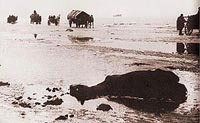 The private breeders and their horses were not allowed to leave until January of 1945, when there was almost no time to escape. In the terrible and cold winter, the "Trek" began; a gathering of tens of thousands of people and some 18.000 East Prussian horses bundled their most precious belongings in wagons and began walking and driving westbound. For many, that included a trip over the barely frozen East Sea over the so called "Frisches Haff", where treks formed on the thin ice and tried to avoid daylight, because with that, bombers came that shot the ice to shreds and left humans and horses drowing in ice cold sea water. The private breeders and their horses were not allowed to leave until January of 1945, when there was almost no time to escape. In the terrible and cold winter, the "Trek" began; a gathering of tens of thousands of people and some 18.000 East Prussian horses bundled their most precious belongings in wagons and began walking and driving westbound. For many, that included a trip over the barely frozen East Sea over the so called "Frisches Haff", where treks formed on the thin ice and tried to avoid daylight, because with that, bombers came that shot the ice to shreds and left humans and horses drowing in ice cold sea water.
Mares were heavy in foal and sometimes there wasn't food for days. Thousands of lives were lost, horses that wouldn't make it any further had to be left behind, the horror of these months is hard to describe in words. Eventually, most East Prussians reached the safety of the West, but at a terrible price. By the end of World War II, Trakehnen was no more. This "Horse Pardise", once a virtual "City of Horses" was laid to waste, and only a handful of Trakehner horses survived the horrific performance test that forever after would be referred to in hushed tones as "The Trek". From the legendary, great mare herds of Trakehnen - once grouped by color - only the strongest survived . . a mere 21 original main stud mares.
Trakehnen and its horses seemed to have been lost forever. It is only because of a few dedicated individuals, totally committed to saving this great treasure, that today the Trakehner is not a footnote in history. The most important stallions were lost during the trek. Some - like Feytsz ox - were shot by the army, others were captured and taken to Kirov, where they established one of today's most powerful sport horses, the Russian Trakehner.
Today, Trakehnen doesn't exist anymore. However, the influence of these impeccably bred animals can be felt even today, 60 years after the downfall. The level of quality achieved in breeding performance horses with high amounts of TB and Arabian blood is unsurpassed and we can count ourselves lucky, if our breed returnes to this level at some point in the future.

A New Beginning
Of the 1.100 once beautiful and proud horses from the main stud Trakehnen, only some 100 individuals survived, many with tremendous
injuries. Additionally, the East Prussian horses that belonged to the private breeders and had made the trek, were scattered all over what
remained of Germany. The following years were spent trying to relocate and collect and catalog these few Trakehners. In October 1947, the "West German Association of Breeders and Friends of the Warmblood Horse of Trakehner Origin", today known as the "Trakehner Verband", was established, replacing the East Prussian Stud Book Society. Together with the Trakehner horses of private breeders from East Prussia, a few hundred Trakehners were available for rebuilding the breed. Now, the biggest thread was the tremendous hunger the people of Germany had to suffer from in the post-war years. The number of horses slaughtered is unknown, but drove the Trakehner breed further towards extinction.
Trakehner foundation mares: Kassette and Polarfahrt
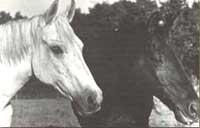
|
The Verband's first president, Baron von Schrötter and his manager, Dr. Fritz Schilke, spent most of their time in the years following the war finding and relocating the horses. In 1950, the state government of Lower Saxony and the German government stepped in to help, providing the Trakehner Verband with a central breeding facility in Hunnesrück, Lower Saxony. Together with the Trakehner stud farms Rantzau and Schmoel, Hunnesrück soon became famous. The last original Trakehner brood mares from the main stud were collected here and used to breed future generations. Great foundation mares like Kassette, Polarfahrt, Donna, Tapete, Halensee, Herbstzeit and others found a last home in these Trakehner farms, together with some of the last sires rescued from the main stud, like the Pythagoras-son Totilas, who was most important to establish the Trakehner breed in West Germany. Smaller private breeders were given the opportunity to board their mares there, the resulting foals belonged to the "Trakehner Gesellschaft", a corporation founded to preserve and promote the Trakehner in West Germany and later the whole world. |
In the former German Democratic Republic (GDR), the situation was much the same. After the Soviet forces had closed the borders, the Trakehner horses that were stranded in the GDR were scattered all around the country and again, Trakehner lovers and enthusiasts, many of them East Prussian breeders that had lost everything, started to collect and breed these horses and maintained a high quality Trakehner population until the reunification of Germany in 1991, when not only the wall came down and Germany grew together again, but when also this fine breed was unified.
It was due to yet another outstanding personality, Dietrich von Lenski, who originated in one East Prussia's biggest private stud farms, Kattenau, that the "Trakehner Förderverein" was established. The Förderverein is an organization that helps to promote the Trakehner in the international sport world by providing exceptional horses to internationally successful riders. Also, young talents are spotted and the owners are funded to maintain a high training standard for these horses.
The most prominent example of such a Förderverein-owned horse was the black Trakehner stallion Habicht (by Burnus AAH out of Hallo by Goldregen). Habicht was given to the Trakehner Verband stud at Hunnesrück for breeding purposes and yet, at the same time, the Förderverein provided the young German rider Martin Plewa with this incredible stallion. The results on both sides were outstanding: Habicht won the international CCI*** at Achselschwang and also established a famous stallion line, today represented for example by his elite son Sixtus and the German premium stallion Windfall, Germany's horse of the Year in 1999 and now an Olympic bronze medal winner for the USA.
In the 1980s, the Trakehner Verband owned three breeding operations: Hunnesrück, Rantzau and Birkhausen, a wonderful farm in the state of Rhineland-Palatinate. From stud Birkhausen, the Trakehner conquered the world. It was in Birkhausen that in 1970 the gray mare Abiza was covered by the bay stallion, Donauwind. She exported in foal to Canada and the resulting colt later became the internationally famous Abdullah. In addition to Birkhausen, several private breeders established new breeding farms, some of them gaining world stature. Webelsgrund for example, founded by Fritz Bähre in the 1950s, was home to the legendary sire Impuls. Also, Hämelschenburg of the Langels family in Emmerthal must be mentioned here, they provided several high studbook and elite mares and outstanding stallions like Kostolany. Gottfried Hoogen's Vogelsangshof was the origin of the best Trakehner dressage sire of all times, Mahagoni, who later moved to yet another famous farm, Hörem of Hubertus Poll, who in later years stood such incredible individuals as EH Consul, EH Rockefeller and today, Buddenbrock. And of course Hörstein, founded by Adam Dreßler in 1962 and today run by his daughter Christa and her husband Wolfgang Diehm always stood out, both nationally and internationally, and was Habicht's home for many years. Hörstein also has to be named as one of Germany's top event horse breeding farms. National and international competitors like Konvoi, Grand Prix, Starway and Windfall came from Hörstein.

The American Trakehner Association (ATA)
In 1957, the German born Gerda Friedrichs, a breeder who had left Germany for Canada began to import West German Trakehner horses. Four stallions came with the first transport: Antares by Kobalt, Prusso by Totilas, Slesus by Tropenwald, and Tscherkess by Tropenwald. Still today, offspring of these individuals are present in the ATA books and the first three of the stallions were highly important for the establishment of Trakehners in North America.
But Gerda Friedrichs not only imported stallion, she also bought mares. A total of 23 Trakehner mares were imported from 1957 to 1963. Also in 1963, the approved Carajan II by Carajan was imported. The last stallion - Mikado by Impuls - came in 1968. With the breeding program expanding, the interest in these horses grew. Soon, the numbers of enthusiasts, riders and breeders was big enough. But just like the West German counterpart in the early 1950s, the American Trakehner friends faced the problem of having many people interested in the breed, but scattered throughout a country. These future ATA members had little knowledge of each other and lacked of centralized organization for guidance. Nevertheless, these individuals had a strong devotion to the horses in which they believed and eventually the American breeders and owners of Trakehner horses grew together. On May 23, 1974, the "American Trakehner Association" was incorporated in Ohio as a public, nonprofit corporation and in 1979, an Agreement of Cooperation was signed between the ATA and the German Trakehner Verband, assuring the ATA the help and support of the German association according to its own guidelines.
 This agreement also granted the ATA use of the double moose antler, this world famous symbol of East Prussia and its people, as the official brand for all purebred Trakehner horses in North America. It is since these early days that Trakehner horses in North America are registered, approved and inspected according to the West German standards. Additionally, the ATA publishes an educational magazine and newsletter, hosts a large annual convention, produces Trakehner exhibitions and provides a central office for information and advice for Trakehner friends. One of the highlights the ATA has to offer is an exciting annual awards system for member-owned, registered performance horses. This agreement also granted the ATA use of the double moose antler, this world famous symbol of East Prussia and its people, as the official brand for all purebred Trakehner horses in North America. It is since these early days that Trakehner horses in North America are registered, approved and inspected according to the West German standards. Additionally, the ATA publishes an educational magazine and newsletter, hosts a large annual convention, produces Trakehner exhibitions and provides a central office for information and advice for Trakehner friends. One of the highlights the ATA has to offer is an exciting annual awards system for member-owned, registered performance horses.
Besides North America, the Trakehner Verband has several international secondary registries, the most influential ones in Denmark, Great Britain, the Netherlands, Russia and Austria. Trakehner horses are bred on all continents of this world, in North and South America, in Europe, Australia, New Zealand, Africa and Asia, often also improving the local riding horse breeds in these countries. A pretty amazing feat for a breed that was almost lost forever...
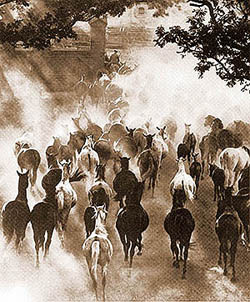
 If you enjoyed our History Site and would like to link to your own homepage, please feel free to do so. We only request that you link back to Trakehners International and give full credit to us. If you enjoyed our History Site and would like to link to your own homepage, please feel free to do so. We only request that you link back to Trakehners International and give full credit to us.
|
